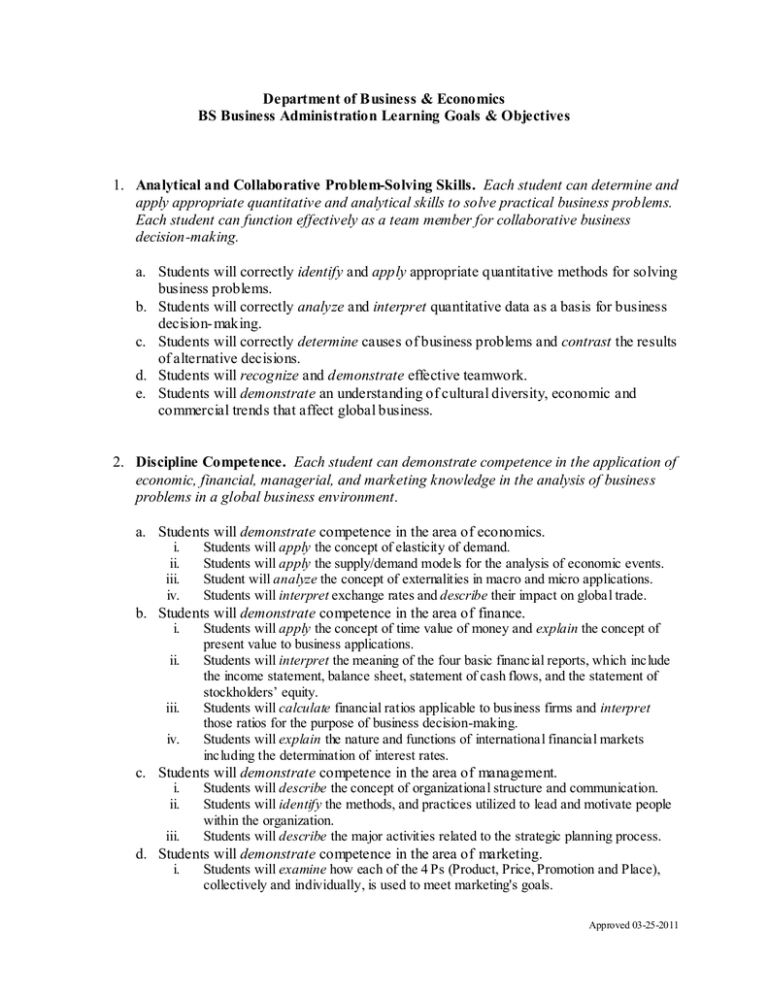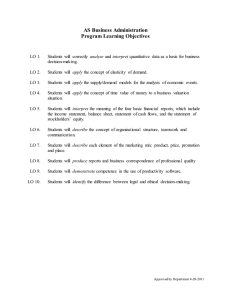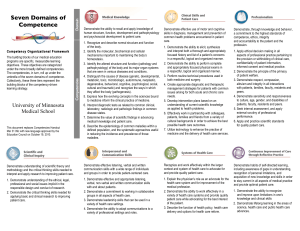Analytical and Collaborative Problem-Solving Skills. Department of Business & Economics
advertisement

Department of Business & Economics BS Business Administration Learning Goals & Objectives 1. Analytical and Collaborative Problem-Solving Skills. Each student can determine and apply appropriate quantitative and analytical skills to solve practical business problems. Each student can function effectively as a team member for collaborative business decision-making. a. Students will correctly identify and apply appropriate quantitative methods for solving business problems. b. Students will correctly analyze and interpret quantitative data as a basis for business decision- making. c. Students will correctly determine causes of business problems and contrast the results of alternative decisions. d. Students will recognize and demonstrate effective teamwork. e. Students will demonstrate an understanding of cultural diversity, economic and commercial trends that affect global business. 2. Discipline Competence. Each student can demonstrate competence in the application of economic, financial, managerial, and marketing knowledge in the analysis of business problems in a global business environment. a. Students will demonstrate competence in the area of economics. i. ii. iii. iv. Students will apply the concept of elasticity of demand. Students will apply the supply/demand models for the analysis of economic events. Student will analyze the concept of externalities in macro and micro applications. Students will interpret exchange rates and describe their impact on global trade. b. Students will demonstrate competence in the area of finance. i. ii. iii. iv. Students will apply the concept of time value of money and explain the concept of present value to business applications. Students will interpret the meaning of the four basic financial reports, which include the income statement, balance sheet, statement of cash flows, and the statement of stockholders’ equity. Students will calculate financial ratios applicable to business firms and interpret those ratios for the purpose of business decision-making. Students will explain the nature and functions of international financial markets including the determination of interest rates. c. Students will demonstrate competence in the area of management. i. ii. iii. Students will describe the concept of organizational structure and communication. Students will identify the methods, and practices utilized to lead and motivate people within the organization. Students will describe the major activities related to the strategic planning process. d. Students will demonstrate competence in the area of marketing. i. Students will examine how each of the 4 Ps (Product, Price, Promotion and Place), collectively and individually, is used to meet marketing's goals. Approved 03-25-2011 ii. iii. iv. Students will describe the uncontrollable environments (economic, competitive, social, cultural, technological, governmental/legal), and explain how current and anticipated conditions in these environments influence marketing planning. Student will describe and apply the concept of market segmentation and positioning. Students will explain the distinction between standardization and customization when companies craft global marketing programs. e. Students will integrate knowledge across functional areas of business in solving a business problem in a global business environment. 3. Communication Skills. Each student can effectively communicate a complicated business issue in both written and oral form using appropriate presentation technology. a. Students will effectively and concisely communicate ideas and opinions related to a complex business issue. b. Students will create and deliver professional presentations using appropriate business presentation technology. c. Students will produce reports and business correspondence of professional quality. d. Students will demonstrate active listening skills. 4. Competence in the Application of Technology. Each student can demonstrate knowledge of information technology and competence in technology applications for making business decisions. a. Students will effectively employ spreadsheets for statistical, relational, and graphical analyses of business data. b. Students will demonstrate knowledge of Enterprise Resource Planning (ERP) system functions in support of business decisions. c. Students will demonstrate competence in the integration of software functions for the professional and effective electronic communication of ideas. d. Students will identify appropriate technology for support of business analysis and decisions. 5. Ethical Decision-making. Each student can identify and evaluate ethical dilemmas and corporate responsibility in business situations and effectively communicate defensible solutions. a. Students will identify an ethical dilemma in a business case, and propose and defend alternative courses of action. b. Students will demonstrate an understanding of the legal environment of business. c. Students will identify the difference between legal and ethical decision- making. Approved 03-25-2011







